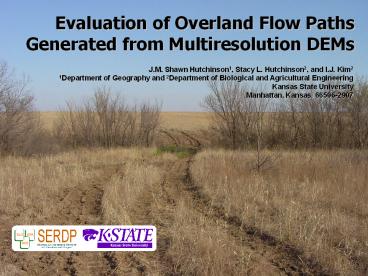Evaluation of Overland Flow Paths Generated from Multiresolution DEMs - PowerPoint PPT Presentation
Title:
Evaluation of Overland Flow Paths Generated from Multiresolution DEMs
Description:
1Department of Geography and 2Department of Biological and Agricultural Engineering ... Extend nLS-0.5 method to identify gully erosion sites... AAG 2005 - Denver ... – PowerPoint PPT presentation
Number of Views:32
Avg rating:3.0/5.0
Title: Evaluation of Overland Flow Paths Generated from Multiresolution DEMs
1
Evaluation of Overland Flow Paths Generated from
Multiresolution DEMs
J.M. Shawn Hutchinson1, Stacy L. Hutchinson2, and
I.J. Kim2 1Department of Geography and
2Department of Biological and Agricultural
EngineeringKansas State University Manhattan,
Kansas 66506-2907
2
The Problem NPS Pollution
- Largest contributors to surface water impairment
are nonpoint source (NPS) pollutants sediment,
nutrients, pathogens, other chemicals
40 of streams in US are considered
contaminated..
Percent of Impaired Waters (1998) HUC 8
Scale www.epa.gov/iwi/2000aug/iv22_usmap.html
3
One Solution VBS
- Vegetated buffer systems (VBS) common and
sustainable BMP for mitigating NPS pollutant
transport
4
VBS Illustrated
Design standards from USDA Farm Service
Agencyand Natural Resource Conservation Service
Source NRCS Photo Gallery
Shrubs nutrient removal
Zone 1
Zone 3
Zone 2
Grass control runoff, sediment
Trees bank stabilization
5
Assumptions
Uniform Sheet Flow A W x L
Concentrated Flow A W x L x ß ß A
Ineffective Area
L
W
Hydrologic and Vegetation Conditions
6
Overall Objectives
- To determine optimal DEM spatial resolution to
model soil erosion processes - To evaluate the efficiency of different VBS
designs
7
N
False-Color CompositeLandsat TM 5 June 7, 1997
8
DEMs and Hydrology
- Zhang and Montgomery (1994)
- 10 m resolution is recommended
- Kuo et al. (1999)
- Hillslope curvature an important factor
- Runoff volume is affected most by DEM resolution
during dry seasons - Moglen et al., (2001)
- Coarser resolution DEMs tend to overestimate peak
stream discharge
9
DEM Creation
- GPS data collected on-site at 3m intervals using
DGPS unit - Raster DEMs created from interpolated point
datasets of varying density 30m, 10m, 3m - ArcHydro tools
- Flow paths - D8 method
7
6
8
5
1
4
2
3
10
30 mUSGS
30 m
10 m
3 m
11
Hmmmm.
- Best resolution DEM for representing flow
processes and ability to capture/assess small
(sub-pixel) BMPs - Traditional flow accumulation flow paths not
sufficient - Compounding assumptions effective VBS relies on
sheet overland flow - Observed channelized flow (rill erosion) need
to identify where channelized flow begins
12
Time of Concentration
- Time of concentration
- twatershed toverland flow tchannel flow
tdetainments - tov equilibrium time when rainfall intensity
equals runoff discharge rate - Differences in the observed and computed tov
results from the transition from sheet to
concentrated flow - Sheet tov measured tov-computed
- Concentrated tov measured gtgt tov-computed
13
Kinematic Wave Equation
- Federal Aviation Administration (1970)
- tov 1.8(1.1-C)L0.50/S0.333
- C rational method runoff coefficient
- Morgali and Linsley (1965) Rogan and Duru (1970)
- tov 0.93(nL)0.6/i0.4S0.5
Primary Variables n Mannings coefficient L
slope length S slope i rainfall intensity
14
When Sheet Flow?
- Ignoring impervious surfaces
- Izzard (1946) iL (in/hr x ft) lt 500
- Not fully verified (Rogan and Duru 1972)
- SCS TR-55 (1986) Slope length lt 300 ft
- Lacks justification (McCuen and Spiess 1995)
15
Kinematic Wave Criteria
- McCuen and Spiess (1995)
- tov 0.93(nL)0.6 / i0.4(S0.5)0.6
- Assessed measured and computed tov from 59 field
sites and lab experiments
16
So What?
- Where calculated values of nLS-0.5 on a hillslope
(or plot) is less than 100, sheet flow is the
dominant flow type. - Apply this measure to guide VBS placement within
a watershed - Good Independent of i (rainfall intensity)
- Problem Spatial estimates of Mannings n
17
(No Transcript)
18
(No Transcript)
19
(No Transcript)
20
Parting Shot
- Flow paths from cell accumulation routines dont
address energy required for initiating rill
erosion - Identifying nLS-0.5 threshold will help place VBS
where they can be most effective, and where model
assumptions are valid sheet flow dominated
slopes - Extend nLS-0.5 method to identify gully erosion
sites
21
Acknowledgements
- Strategic Environmental Research and Development
Program - Assessing the Impact of Maneuver Training on NPS
Pollution and Water Quality - Project CP-1339
- Geographic Information Systems Spatial Analysis
Laboratory, Kansas State University
22
Applying the nLS-0.5 Criteria
23
Operational Requirements
- Hydrologic Condition
- Maintaining uniform sheet flow through buffer
- Overland flow often becomes concentrated (Dillaha
et al. 1986 Fabis et al. 1993 Dosskey et al.
2002) - Vegetative Condition
- Maintaining healthy dense vegetation growth
- Vegetation condition varies within and between
years
24
- Models assume sheet flow
- Best resolution DEM for representing flow
processes and ability to capture small BMPs - Traditional flow accumulation flow paths not a
sufficient for - Assuming VBS effective in removal but its
assumption is overland flow - Observed channelized flow need to understand
where channelization initiates and not violate
model assumptions - Rill erosion (up to 200 mm deep) is onset of
channelization biggest cause of sediment
transport (enough water with enough energy to
move dirt)































